



Russian Feed Sector Continues to Expand
RUSSIA - The Russian feed sector is continuing to develop rapidly, supported by strong growth in the livestock and poultry sectors and the introduction of new technologies and improved quality. Despite this, major weaknesses in the sector remain including outdated facilities and technologies, insufficient domestic production facilities for acids and vitamins, and a lack of sufficient domestic production of certain feed grains and oilseeds. At the 7th International Conference "Compound Feeds-2013" in February 2013, presenters from the Ministry of Agriculture and the feed industry commented on opportunities and constraints for the feed sector in Russia.Overview
The 7th International Conference “Compound Feeds-2013” was held on 5-7 February 2013 in Moscow, Russia, and was organized by the Russian Ministry of Agriculture, the Russian Feed Union, the All-Russian Scientific Feed Institute, and the International Industrial Academy. The conference brought together government officials from both federal and local levels, and more than 280 participants from 40 Russian regions, including regional agricultural leaders, scientists and technologists, as well as representatives from ten foreign countries, such as Germany, Belgium, the United States, the Netherlands, and others.
At this conference, speakers presented on the current state and future prospects of feed production in Russia. The general tone of the conference and message of the presenters was the positive trends in the feed sector, and the significant development potential for feeds in Russia. Recent growth has been driven by the National Agricultural Development Program 2008-2012, which spurred strong growth in poultry and swine production. Since 2008, annual feed production demonstrated sustained annual growth from 7-10 per cent.
Despite solid growth, as at past conferences, speakers also pointed out a number of obstacles to the further development of the feed sector in Russia, including:
- High sensitivity of the sector to the fluctuations in the grain market (which can experience significant swings in production due to climatic conditions of Russia);
- Insufficient production of certain feed grains, legumes, and oilseeds domestically;
- Poor digestibility of domestic feed as it typically has too high of a concentration of grain and too little protein;
- Lack of modernization in feed facilities and lack of innovative technologies;
- Deficit of professionals in feed production and animal nutrition.
Some of the highlights of this conference included the following presentations:
Ministry of Agriculture Presentation
Vladimir Manayenkov, the Head of the Feed Office in the Department of Animal Breeding, Russian Ministry of Agriculture, presented on the development of the feed sector in Russia. He reported that government measures aimed at improving the agricultural sector in Russia have resulted in strong growth, specifically in the swine and poultry industries, and this growth has led to increased demand for compound feeds. As a result, feed production (both compound and non-compound feed) in Russia has continued to grow, with total feed production estimated up 1 million metric tons (MMT) in 2012 from 2011. Feed production is primarily for use in the poultry sector, with 59 per cent of feeds for poultry, followed by swine at 30 per cent and finally livestock at 10 per cent; other types such as for aquaculture are just 1 per cent (see Chart 1).
Chart 1
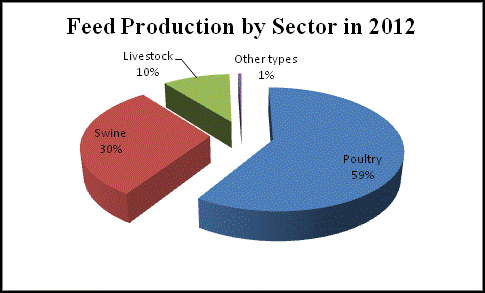
Source: Russian Ministry of Agriculture
According to Rosstat, Russia produced 20 MMT of feeds in 2012, which is 5.4 MMT or 37 per cent more that in 2009. Mr Manayenkov mentioned that there is a 5 MMT discrepancy between official Rosstat data for production of feeds versus production data that the Ministry of Agriculture received from the regions, and according to regional statistics, Russia total feed production is around 25 MMT. One of the tasks of the Ministry is to have better interaction with Rosstat in order to harmonize these numbers and come up with an accurate and consistent feed production number for Russia. According to other speakers at the conference, this discrepancy arises because most poultry and pork facilities operate their own feed mills and this production of feed for internal company use is not registered by the government. Despite strong growth in feed production, current levels are still far below levels of production during the Soviet Union - when Russia was a huge importer of grains, and beef production was nearly triple than it is currently, and when feed production regularly reached over 50 MMT annually.
Positive growth trends in feed production are expected to continue as a result of government efforts to continue to support livestock production in the new Government Program for Agricultural Development for 2013-2020.
Mr Manayenkov reported that the major objectives under this program include:
- Livestock and poultry production for slaughter in live weight to increase to 14.07 MMT by 2020;
- Milk production increase to 38.2 MMT;
- Export increase of poultry to 400,000 MT, of pork to 200,000 MT.
He stressed that to meet these goals and objectives, it was essential to have a strong and balanced feed ingredients base.
Russian Feed Union Presentation
A report on the current developments of the feed sector in Russia came from Valeriy Afanasyev, President of the Russian Feed Union. According to the Union’s data, annual production growth in the sector since 2008 is estimated at 2.5 MMT per year and this has been driven by feeds for poultry and pork.
Mr Afanasyev reported that 285 major feed production facilities operate currently in Russia. In addition, the Union estimates there are about 193 feedlots operations with smaller annual capacities (see Chart 3 for breakout). Feed production is concentrated in Central Federal district with 39 per cent produced there by volume, followed by North Western Federal District with11 per cent, and the Siberian Federal District with 10 per cent. The Central Federal district is where poultry and swine production is concentrated in Russia, and this is why it dominates in feed production (see Chart 4).
Chart 2
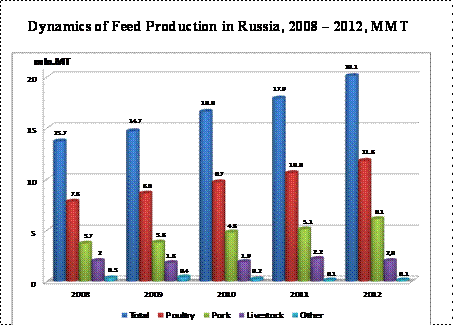
Source: Russian Feed Union
Chart 3
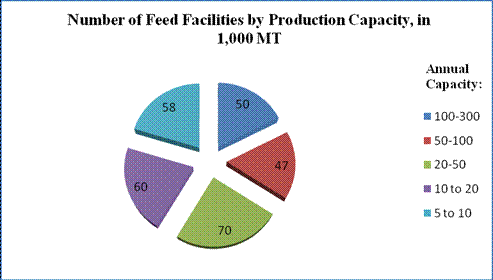
Source: Russian Feed Union
Chart 4
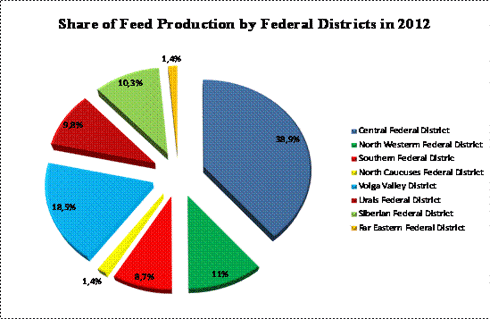
Source: Russian Feed Union
Mr Afanasyev highlighted problems facing the sector. He emphasized that as a result of use of non-balanced feed ratios in terms of proteins and amino acids, in Russia animals often have to consume twice the amount of feed in volume as those prescribed in the norms in other countries. He presented the answer as creating more balanced feeds in Russia in incorporating by-products from the food industry in the production of feeds, for example using corn gluten, molasses, dried sugar beet chips, brewing waste and distillers dried grains. He cited the example of sugar beet pulp as an example of a by-product that could be better utilized. Russia produces 31 million MT of beet pulp annually, and according to the Ministry of Agriculture, and 30 per cent of the total is being processed for granulated beet chips (almost all of it is exported), 44 per cent of beet pulps are used directly as feed, and 26 per cent of beet pulps are simply wasted and not used. This is according to the Ministry of Agriculture, but he stated that specialists believe that unused beet pulp is much higher. Currently, the feed union estimates the share of grain in animal feeds in Russia at 70 per cent, compared to just 40-45 per cent on average in the European Union (See Charts 5-6). Because of the higher per centage of grain in the feed rations, large fluctuations in grain prices can severely impact feed prices, as happened this past year with the smaller Russian wheat crop (see Chart 7).
Chart 5
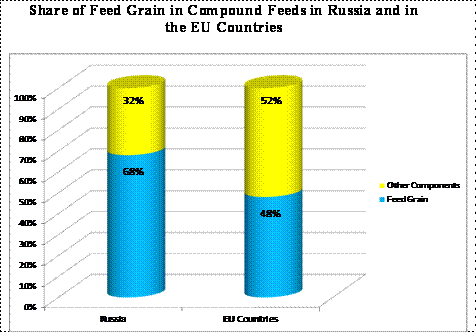
Source: Russian Feed Union
Chart 6
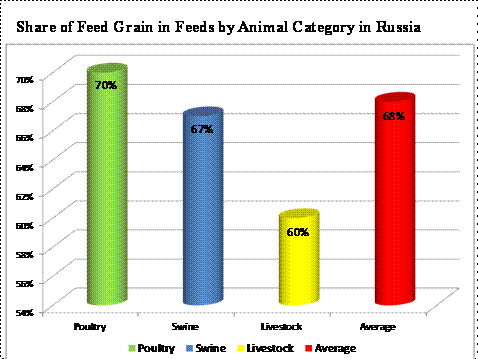
Source: Russian Feed Union
Chart 7
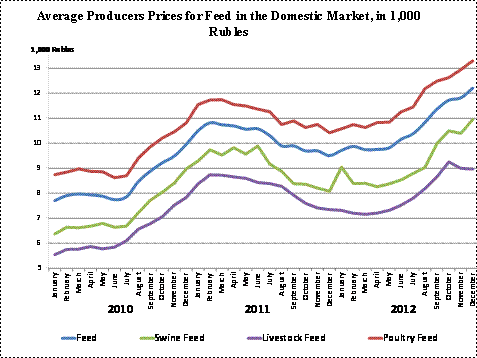
Source: Russian Feed Union
For premixes and biological mineral concentrates, although the production of these continue to climb rapidly in Russia, the country is still dependant on imports of raw materials, mainly for vitamins and amino-acids, as well as ferment preparations. This need for imported inputs raises the overall cost of feed in Russia.
In conclusion, Mr Afanasyev noted the fact that Federal Program on the Development of Agriculture in 2013-2020 lacks any specific subprogram for Feed Sector. Although it does support livestock and poultry production, there is no specific program for feeds. Mr. Afansayev stated that the Russian Feed Union is trying to work with and convince the Ministry of Agriculture to create a subprogram for feed. However, there is no information yet whether the GOR will consider including the sector in the master Program.








